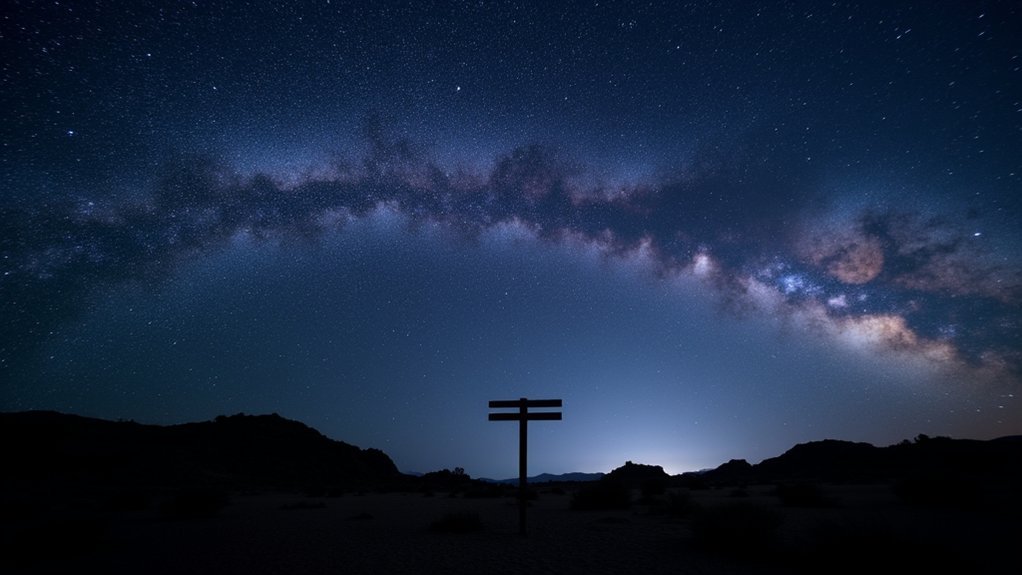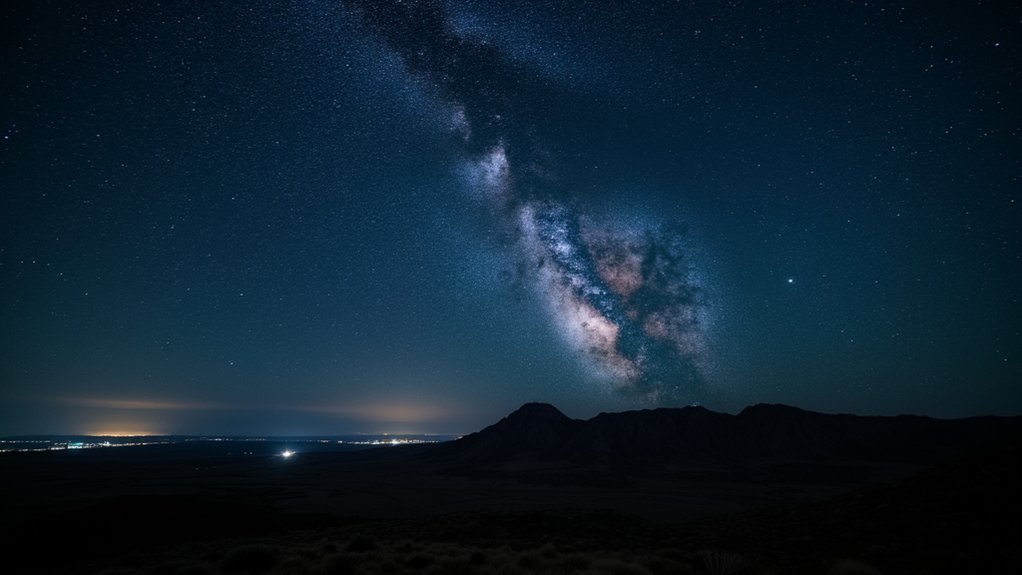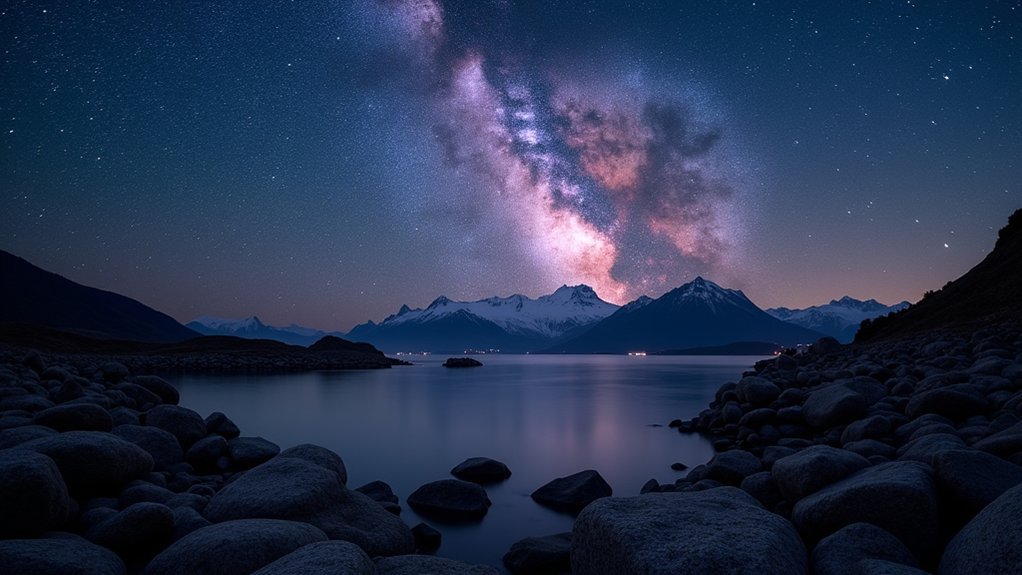Seven essential permits for night sky photography include National Park Special Use Permits, BLM Photography Authorizations, State Park Nighttime Permits, Dark Sky Area Access Passes, Private Land Owner Permission Documents, Special Event Credentials, and Observatory Access Credentials. You’ll need these to avoid fines, gain legal access to prime locations, and shoot respectfully in protected areas. Each permit has specific requirements, fees, and application processes that can help you capture stunning celestial images without legal complications.
7 Must-Have Permits For Night Sky Photography

Before you set up your tripod under the stars, you’ll need to secure the proper photography permits to avoid potential fines or being asked to leave your shooting location. National parks, which often feature the darkest skies, typically require specific documentation that grants you legal access for night photography.
Permit costs vary greatly—from $50 at smaller parks to thousands for premium photography locations. Complete your application well in advance through official websites or by contacting property management directly. This guarantees compliance with local regulations and secures your shooting rights.
Always carry physical copies of your permits during sessions, as rangers frequently check documentation. Beyond legality, obtaining proper permits promotes a respectful shooting environment, reducing potential conflicts with authorities and other photographers while maximizing your access to prime stargazing spots.
National Park Special Use Permits for After-Hours Access
When capturing the Milky Way or meteor showers in national parks, you’ll need a Special Use Permit to legally access these prime dark sky locations after regular closing hours.
Submit a detailed proposal outlining your planned photography activities, specific locations, and how you’ll minimize environmental impacts.
Be prepared for varying fees—permits typically cost between $50 and several hundred dollars, depending on your project’s scope and duration.
Many parks designate specific areas for night photography to protect wildlife and limit disturbance to other visitors.
Don’t wait until the last minute to apply. Processing times can stretch to several weeks, especially during busy tourist seasons.
Plan ahead and submit your application early to guarantee you’ll have proper authorization when those perfect dark skies arrive.
Bureau of Land Management (BLM) Photography Authorizations

When shooting night skies for profit on BLM land, you’ll need to apply for a photography authorization at least 10 days before your planned shoot.
You must detail your shooting plans, including location specifics and duration, while paying the appropriate processing fee that varies based on your project’s scale.
Remember that certain BLM recreation areas might impose additional restrictions to protect wildlife and cultural resources, so check with local offices before finalizing your astrophotography plans.
Commercial Use Requirements
If you’re planning commercial night sky photography on lands managed by the Bureau of Land Management, you’ll need to secure a photography authorization.
Under BLM regulations, commercial photography includes any activities using models, sets, or props, as well as shoots that generate income or promote a business.
To protect natural resources, the BLM requires you to submit your application at least 10 days before your planned photography activities. This provides adequate processing time for approval.
Fees typically range from $50 to several hundred dollars, depending on your specific location and shoot type.
Don’t risk the consequences of shooting without proper authorization—you could face fines, immediate removal from the site, and potential bans from future photography on BLM lands.
Recreation Area Restrictions
Specialized recreation areas managed by the BLM often implement stricter photography regulations to preserve their unique natural features and minimize visitor disruption.
When planning night sky photography sessions, you’ll need to understand BLM regulations regarding photography authorizations, particularly for commercial shoots.
- Photography permits cost between $50 and several hundred dollars depending on location and project scope.
- Submit applications to your local BLM office well in advance to accommodate variable processing times.
- Commercial shoots and extensive equipment setups require special authorizations due to environmental protection concerns.
- Drone photography in BLM areas often needs additional permits and must follow specific guidelines.
- Always research the recreation area restrictions for your specific location, as rules vary by region regarding access and environmental protection measures.
State Park Nighttime Photography Permits
State parks require specific nighttime photography permits that you’ll need to apply for well in advance, often through online portals or by contacting park offices directly.
You’ll find most state parks enforce strict closing hours, but permit holders typically receive special exceptions allowing access during otherwise restricted nighttime periods.
When planning night sky shoots that involve multiple photographers or models, you’ll need to check if your activity qualifies as a “special event” requiring additional authorization beyond the standard photography permit.
Permit Application Processes
Because regulations vary greatly between locations, obtaining your state park nighttime photography permit requires careful research and planning. Start by visiting the park’s official website where you’ll find application forms and specific guidelines. Remember that permit fees typically range from $10 to $50, depending on your shooting duration and the park’s policies regarding light pollution management.
- Submit your application well in advance to account for varying processing times
- Prepare a detailed shooting plan including equipment list and specific locations
- Be aware that some parks have seasonal restrictions on nighttime access
- Budget for application fees, which support park conservation efforts
- Always carry a physical copy of your approved permit during your shoot
Compliance with park regulations guarantees continued access for all photographers while protecting natural habitats and wildlife from disruption.
Closing Hours Exceptions
Standard park closing hours typically don’t accommodate the timing needs of astrophotographers. Most state parks restrict access after dark, creating a significant obstacle for night sky photography enthusiasts.
This is where a nighttime photography permit becomes crucial, allowing you to legally remain in the park beyond regular closing hours. These special permits grant you extended access to capture celestial events without interruption.
However, regulations vary widely between parks, so you’ll need to research specific park guidelines before planning your shoot. Some locations offer designated photography nights or special programs for astrophotographers.
Remember that failure to obtain required permit requirements can result in fines or being asked to leave by park officials. Always check with park administration about nighttime photography permits well before your planned visit to guarantee a hassle-free experience.
Special Event Restrictions
When meteor showers and other celestial events draw crowds, you’ll need to navigate additional permit restrictions beyond standard nighttime access.
State parks impose special regulations during peak seasons to protect their environments while accommodating night photography enthusiasts. Your permit applications must detail equipment use, group size, and shooting duration.
- Fees typically range from $25 to several hundred dollars depending on location and shoot length
- Tripods may face restrictions in environmentally sensitive areas
- Photography permits often specify valid hours for nighttime photography
- Park regulations might limit the number of participants allowed
- Lighting equipment usage is typically regulated to minimize environmental impact
Always check the specific park’s website or contact management directly before planning your shoot, as requirements vary considerably between locations and may change seasonally.
Local Municipality Dark Sky Designations and Access Passes
Numerous local municipalities across the country have established designated Dark Sky areas where photographers can capture celestial wonders without the interference of light pollution.
To access these protected locations, you’ll need specific permits that help preserve the nocturnal environment. When applying for these access passes, expect a review process that evaluates your photography activities’ environmental impact.
Most Dark Sky areas enforce strict guidelines on artificial lighting usage to maintain pristine night sky conditions. Fees vary greatly depending on location and access duration—from minimal charges to substantial costs.
Many locations require annual permits for entry to specialized viewpoints or facilities designed for night sky photography. Before planning your shoot, check with the local municipality regarding their specific Dark Sky designation requirements and restrictions to guarantee full compliance.
Private Land Owner Permission Documents for Remote Locations

Securing written permission from private landowners represents a critical step for night sky photographers seeking access to remote locations with minimal light pollution.
When approaching landowners, clearly document the terms in a permission letter that outlines your photography project’s scope and duration to establish mutual understanding.
- Always carry your permission document during shoots in case authorities question your presence
- Include your contact information to foster transparency and build trust with the landowner
- Specify any restrictions and the intended purpose of your photography in writing
- Consider offering high-quality images or photography credits as tokens of appreciation
- Document everything properly to avoid potential legal issues that could arise from unauthorized access
This proactive approach not only protects you legally but often leads to valuable long-term relationships with property owners.
Astronomical Observatory Vicinity Access Credentials
Professional astronomical facilities typically require specific credentials for night photographers seeking to work near their premises.
You’ll need to research each observatory’s access guidelines before planning your shoot, as requirements vary considerably between institutions.
Many observatories offer public viewing events where formal permits aren’t necessary, but you should register in advance to secure your spot.
For photography beyond these sessions, you’ll need to obtain proper credentials and adhere to strict restrictions designed to protect sensitive equipment and ongoing research.
Before visiting, check the observatory’s website or contact administrators directly about photography permissions.
They’ll inform you about potential restrictions on flash photography, tripods, and timing limitations during active research periods.
Some facilities may charge fees for specialized photography permits, particularly for commercial work.
Frequently Asked Questions
What Is the 500 Rule in Night Sky Photography?
The 500 rule helps you calculate maximum exposure time without star trails. Divide 500 by your lens’s focal length (in mm). For example, with a 50mm lens, you’d use a 10-second exposure maximum.
What Equipment Do I Need for Night Photography?
You’ll need a full-frame camera with manual settings, a fast wide-angle lens (f/2.8 or wider), sturdy tripod, remote shutter release, and extra batteries for successful night photography sessions.
Do You Need Permission for Street Photography?
You don’t generally need permission for street photography in public spaces. However, you’ll need consent when shooting on private property or for commercial purposes. Always check local regulations for specific requirements.
How Do You Start Night Sky Photography?
To start night sky photography, you’ll need a camera with manual settings, tripod, and wide-angle lens. Find a dark location, set long exposure times and high ISO, and shoot during moonless nights for best results.
In Summary
Don’t let permit issues ruin your night sky photography adventure. Research and secure all necessary permits well before your shoot. You’ll need to navigate different requirements for national parks, BLM lands, state parks, local dark sky areas, private properties, and observatory vicinities. With proper documentation in hand, you’ll avoid fines and focus on capturing those breathtaking celestial images you’ve been dreaming about.





Leave a Reply